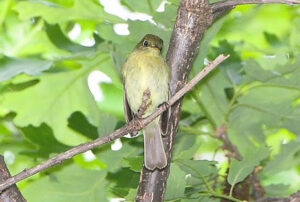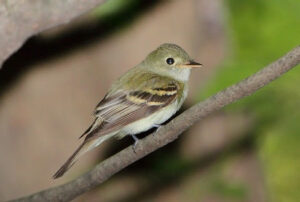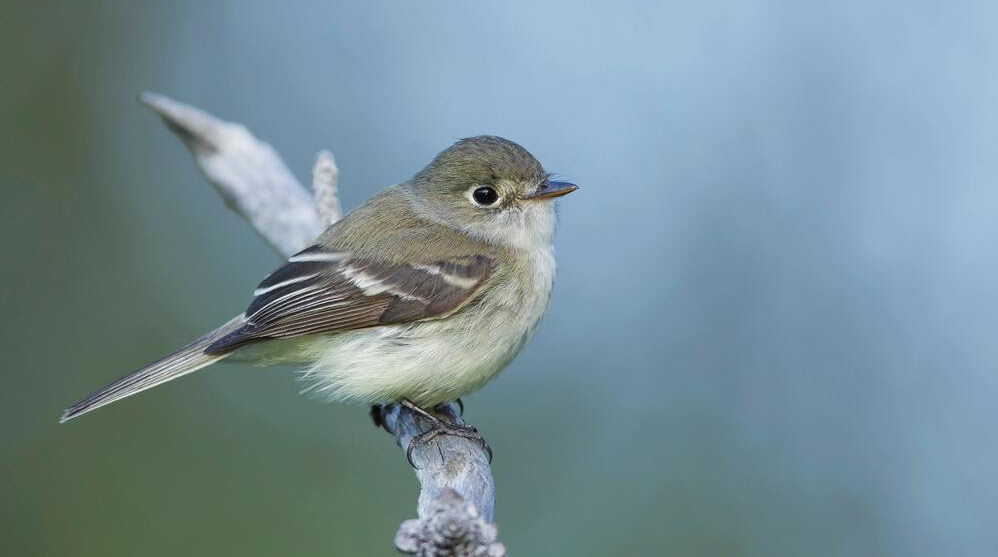Least Flycatcher, Empidonax minimus
Bill Rowe
Following the plan of “spring migrants in May,” here’s one that is common, likely to show up in your yard or local park, and typical of a group of flycatchers that everyone wrestles with as they learn about birds. This is the genus Empidonax, a name coined from Greek, meaning “king of the gnats.” As a group they are our smallest flycatchers, the size of a sparrow, rather plain-colored, and so similar to each other that often they can be firmly identified only by their songs and calls. Kenn Kaufmann, in his excellent Field Guide to Advanced Birding, devotes 40 pages to the eleven species of “empids” in North America. (Luckily, we have only five to deal with in our area.) The Least Flycatcher passes through in good numbers, both spring and fall, on its way to its breeding grounds in Canada and the more northern states—for instance, all of Minnesota, Wisconsin, and Michigan, and down to northern Illinois—where it will nest in various types of deciduous and mixed forest. Unlike many woodland birds that are rather uniformly distributed throughout their habitat, research shows that Least Flycatchers have a tendency to cluster on territories close to each other, almost like a colony, separated by stretches of seemingly unused habitat. When we see them on migration, they are apt to be anywhere with trees and shrubbery, actively flitting around for insect prey, flicking their wings and tail, and sometimes singing and calling.
IDENTIFICATION: OK, here goes. In May, if you see a small flycatcher, you have to separate it from other migrants and from breeding residents. STEP 1: Is your bird very small, with two definite wingbars and an eyering? So far, so good. The size and the eyering mean it is an empid and not an Eastern Wood-Pewee. STEP 2: Is your bird whitish on the throat and breast, though possibly with some yellow lower down? Also good; this means it’s not a migrant Yellow-bellied Flycatcher, which is yellowish all the way up onto the throat. STEP 3: Are you in a regular woods or a park, as opposed to a wetland area with willows? Still good; your bird is probably not a resident Willow Flycatcher or migrant Alder Flycatcher, which wouldn’t be likely to show up where you are. STEP 4: Look hard, now: Does your bird have a nice bold white eyering, small bill, and short wingtips that extend out only slightly past the rest of the wing? Excellent: you have most likely eliminated our woodland resident Acadian Flycatcher and are probably safe in calling it a Least Flycatcher. BUT TO BE SURE, take STEP 5: Follow it around and listen for its song, a snappy che-BEK, or its call-note, a simple abrupt whit. Good work, and look at the photos above (a typical Least) and below (two others).
ST. LOUIS STATUS: Common migrant, in late April and May and again in August-September.
Learn more and listen to the songs and calls of Least Flycatchers here.


Yellow-bellied Flycatcher: Like Least but yellow on throat and breast. Not always this obvious!
Photo Credit: Al Smith
Acadian Flycatcher: Very similar to Least but greener with larger bill, thinner eyering, longer wing points.
Photo Credit: Al Smith




